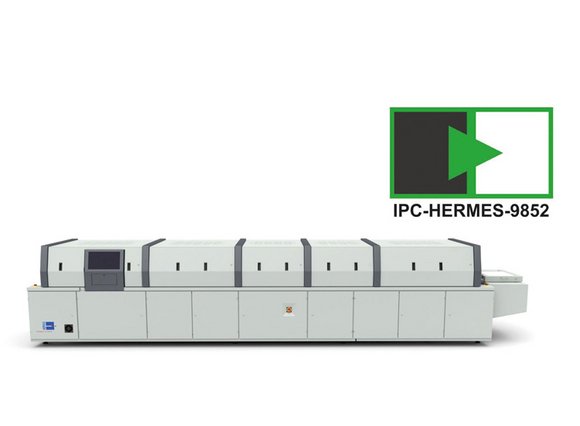Fast, network-based communication between the individual machines is enabled by the Hermes Standard: an option that was unavailable with the previous SMEMA standard. For this reason, an independent group of leading SMT equipment manufacturers, including Rehm Thermal Systems, has come together to develop a new interface: The Hermes Standard. With the previous SMEMA interface, communication from individual machines was reduced to digital signals: Machines did not communicate directly with each other; instead, the circuit board data was held in the MES systems at a higher level. A scanner was required in front of each machine to identify the assemblies.
By contrast, the HermesStandard links the individual machines together via a direct form of horizontal communication. Data is exchanged throughout the entire SMT line, directly from machine to machine (M2M), and the data packets move through the machine together with the circuit boards. The Hermes data package is initially created at the start of the production line. There the barcode is printed, lasered or read in via a scanner. This data package is now communicated from machine to machine together with the circuit board. The new extension of the vertical interface introduced with Hermes 1.2 allows the circuit boards to be tracked in a production line or provides the option of synchronising the assembly’s data with an MES. This new form of interface communication is via TCP/IP and XML-based protocol, which uses standardised Ethernet hardware components and a flexible data format. This simplifies the integration process and reduces costs. In addition to the barcode of the assembly, other types of data (e.g. product, width, transport speed and similar) are communicated.
Customers of Rehm Thermal Systems seeking Hermes interface communication for the convection soldering system VisionXP+ can choose between two versions: one with a scanner on the outfeed conveyor and one without. Without the scanner on the outfeed conveyor it is not possible to manually reinsert a board. This reduces the risk of data being lost or being assigned to the wrong assemblies. If a scanner is present on the outfeed conveyor, boards can be removed after soldering and reinserted as the user requires. This is particularly important if a visual inspection is performed manually or if random samples are to be taken for quality assurance purposes. The correct assignment of data to the correct board is nevertheless preserved.
The convection soldering systems of the VisionX series from Rehm are also CFX-ready. With the CFX interface (IPC-CFX), communication is vertical and network-based. While the Hermes Standard is used primarily for M2M communication, the CFX is used for data uploading and downloading and for data analysis. The combination of horizontal Hermes communication and vertical CFX communication is absolutely necessary for a smart factory in the long run and represents a further step towards standardisation.
